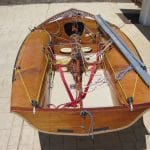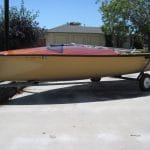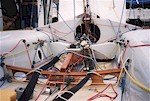

 |
||

 Pictures of a typical mid 1990’s fully rigged Waterat |
Specification
|
|
 |

 |
 |
|
WATERAT SAILING EQUIPMENT – 505 CLASS RACING DINGHY Waterat Sailing Equipment is still in business, but is no longer building 505’s. The final batch of three boats was completed in 2012. Waterat was founded by Larry Tuttle, who had previously been a partner at Mark Lindsay building 505s, and had later worked with Howard Hamlin on the Hamlin 505s. Waterat’s first three 505s were wood and wood veneer finished boats built on Hamlin hulls (the prototype for this batch of three, 7200, Larry’s own, was built on a Lindsay hull). In their use of wood, these boats resembled the Lindsays, except they had cored veneer covered foredecks unlike the plywood foredecked Lindsays, and had oak rather than mahogany veneer on the seat tanks. Waterat acquired the Hamlin tooling in early 1983, and began building mostly plastic 505s. The wooden veneer finished boats were discontinued. Two versions of plastic 505 were built, a glass with foam core boat, and a honeycomb cored boat with some Kevlar in the skins. Both boats were built with epoxy resin. Eventually, the foam-and-glass model was discontinued. The early foam core boats used Clark foam, while the later ones had a PVC foam core. Waterat now builds all boats with epoxy resin, glass & Kevlar skins, and honeycomb core. The V2 specification is carbon fiber forward of the shroud chainplates and Kevlar aft of the aft thwart. In preparation for the 2004 World Championship in Santa Cruz, CA, Trevor Baylis worked closely with Larry Tuttle to put together the most innovate 505 the class had seen in many years. The most notable feature was a offset launcher tube which allowed the boat to take advantage of the forward tack position while still having the performance benefits of the launcher. After this boat was built, Henry Amthor convinced Larry Tuttle to produce an offset launcher conversion kit for the many Lindsay, Hamlin, and Waterat bag boats that were still racing. Since 2004, the tack forward offset launcher has gained popularity, as many people see this arrangement as the best of both worlds. Pictures of one of the first “wood look” Waterats USA 7349: |


 |
||

 Pictures of a typical mid 1990’s fully rigged Waterat |
Specification
|
|
 |

 |
 |
Jib sheeting detail on 7200. This boat has the standard Waterat fore-and-aft jib lead tracks, but also has a barber hauler to pull the lead out. Note that the barberhauler pulls the lead forward (or down) as it pulls it outboard. A light shockcord pulls the floating barberhauler block down to a Ronstan cheek block mounted above the jib cleating platform. This does not alter jib lead angle, but prevents the barberhauler block from getting tangled on something, or from scarring the finish on the seat tank. |
 |
 |
||
| USA7200 Built by: Larry Tuttle (in 1979-80). Current owner: Ali Meller | |||
On most Waterats, the shroud system is in front of the diagonal bulkheads. You can see the shroud extension emerging from a tube in the seat tank, forward and slightly above the jib cleating platform. It runs through a slot in the bulkhead, to a triple wire block. A wire tackle runs between that triple block and a 2nd fastened on the mast step. The wire comes off the tackle and is turned to run aft along the base of the centerboard trunk. The wires from both shrouds run down the same side of the centerboard trunk, are combined, and deadended on a double block with a rope tackle. On 7200, this rope (line?) is run to both seat tanks, so that the shrouds (and the forestay) are adjustable on the seat tank rather than close to centerline on an aft thwart as on most Waterats. 7200 does not have a forward thwart.
|
|
— Sv.505 Förbundet — Uppdaterad 2020-11-02 |